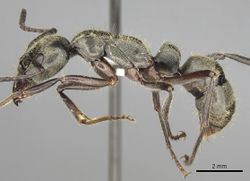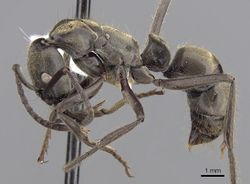Key to Neoponera foetida species complex: Workers
This worker key is based on: Fernandes, I.O., De Oliveira, M.L. & Delabie, J.H.C. 2014. Description of two new species in the Neotropical Pachycondyla foetida complex (Hymenoptera: Formicidae: Ponerinae) and taxonomic notes on the genus. Myrmecological News 19, 133-163.
This key was published before Neoponera was revived as a genus. All of the species are in the genus Neoponera not Pachycondyla.
The workers and queens can be easily differentiated from those of the other species complexes by the combination of the following features: notopropodeal groove deep and well-marked on the mesosomal dorsum; pronotal carina well-developed; petiole subquadrate, with well-developed lateral carina; body surface entirely covered with dense pubescence and golden erect hairs. The males can be differentiated by the combination of the following features: carina present between the antennal insertions; pronotal carina absent; body surface entirely covered with dense pubescence and golden erect hairs. No significant differences in the morphology of male genitalia were observed among the species of the Pachycondyla foetida species complex.
Diagnosis of Pachycondyla (=Neoponera) foetida species complex
Worker: Body surface entirely covered with dense pubescence and golden hairs; palps covered by sparse pubescence, with palpal formula 4:4; malar carina well-developed; eyes large and oval (0.77 - 0.82 mm) located on anterior half of head; lateral pronotal carina well developed with exception of Pachycondyla zuparkoi (lacking carina) and P. billemma (not reaching the mesonotum); notopropodeal groove deep, well-marked on mesosomal dorsum; petiole subquadrate in lateral view, with anterior face vertical or concave, and posterior face broadly rounded; stri-dulatory file on abdominal pretergite IV well developed.
Queen: Very similar to worker, except for malar carina sharper than in worker; mandibles slightly opaque; sharp pronotal carina; well developed scutum and scutellum reduced; well marked mesometanotal and metanotal-propodeal grooves; gaster larger than in the worker.
Male: Body surface covered entirely with golden-silver pubescence and erect golden hairs; body black or brown; yellowish, brown or black legs; palps covered by sparse pubescence, with palpal formula 6:4; eye well developed and expanded dorsolaterally; fine carina present between insertion of antennae; malar carina absent; clypeus convex medially; lateral pronotal carina absent; parapsidal sutures and mayrian sutures present on the scutum; well-marked mesometanotal and metanotal-propodeal grooves; petiole rounded dorsally in lateral view, more smaller and slender than in workers; gaster black or yellowish; stridulatory file of abdominal pretergite IV well-developed; parameres well-developed with apex round and sparse hairs on surface; ventral margin of parameres concave; aedeagus with tiny teeth on ventral margin, and with hairs on dorsal margin; cuspis of volsella elongated and curving ventrally, with round apex and numerous hairs in ventral view; digitus meeting the teeth on ventral surface.
You may also be interested in
- Neoponera
- Key to queens of Neoponera foetida species complex
- Key to males of Neoponera foetida species complex
1
- Side of petiole with horizontal striae . . . . . 2
- Side of petiole without horizontal striae . . . . . 4
2
return to couplet #1
- Dorsum of head with coarse striae, much different than surrounding sculpture; Mexico south to Panama . . . . . Neoponera lineaticeps
- Dorsum of head without coarse striae, if striae present sculpture similar across entire dorsum of head . . . . . 3
3
return to couplet #2
- Posterior face of petiole completely covered with coarse, transverse striae; Mexico south to Bolivia . . . . . Neoponera foetida
- Posterior face of petiole without striae, or with poorly defined striae; Costa Rica to Brazil . . . . . Neoponera theresiae
4
return to couplet #1
- Anterior face of petiole clearly concave . . . . . 5
- Anterior face of petiole straight, vertical, or slightly curved at apex . . . . . 7
5
return to couplet #4
- Posterior face of propodeum laterally without dentate edge; anterior face of petiole in lateral view strongly concave; anterodorsal part of petiolar node in dorsal view weakly marked; SL < 2.39 mm; Mexico south to southern Brazil . . . . . Neoponera inversa
- Posterior face of propodeum laterally with dentate edge; anterior face of petiole in lateral view weakly concave; anterodorsal part of petiolar node in dorsal view strongly produced; SL > 2.40 mm. . . . . . 6
6
return to couplet #5
- Median portion of clypeus with strong transversal striation; pronotal carina poorly developed (not reaching the mesonotum); petiole with striae on anterior face; northern to southeastern Brazil . . . . . Neoponera billemma
- Median portion of clypeus with strong longitudinal striation; pronotal carina well developed; petiole without striae on anterior face; Nicaragua to southern Brazil . . . . . Neoponera curvinodis
7
return to couplet #4
- Pronotal carina inconspicuous (carina lacking); known only from Huánuco, Peru . . . . . Neoponera zuparkoi
- Pronotal carina sharp . . . . . 8
8
return to couplet #7
- Clypeus covered by longitudinal striae; known only from Costa Rica . . . . . Neoponera dismarginata
- Clypeus striate on the anteromedial area . . . . . 9
9
return to couplet #8
- Anteromedial area of clypeus with conspicuous horizontal striae; known only from Costa Rica . . . . . Neoponera insignis
- Anteromedial area of clypeus with longitudinal striae or with fine striae obliquely angled . . . . . 10
10
return to couplet #9
- Medial part of clypeus with longitudinal ditch or furrow surrounded by longitudinal striae; known only from Heredia, Costa Rica. . . . . . Neoponera solisi
- Medial part of clypeus without longitudinal ditch or furrow surrounded by longitudinal striae . . . . . 11
11
return to couplet #10
- Relatively small, head width < 2.00 mm, rarely collected; Nicaragua south to Ecuador . . . . . Neoponera bugabensis
- Relatively large, head width > 2.00 mm . . . . . 12
12
return to couplet #11
- Posterior face of the petiole convex; clypeus with coarse striae; anterior margin of clypeus concave medially; southern United States to Paraguay . . . . . Neoponera villosa
- Posterior face of the petiole nearly convex; clypeus finely striate; anterior margin of clypeus rounded and moderately convex; petiole longer than high in lateral view; Costa Rica to southern Brazil . . . . . Neoponera bactronica

















